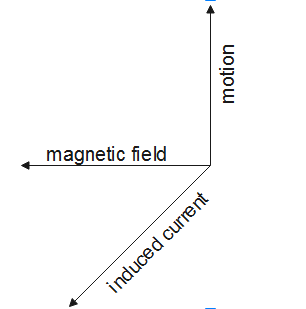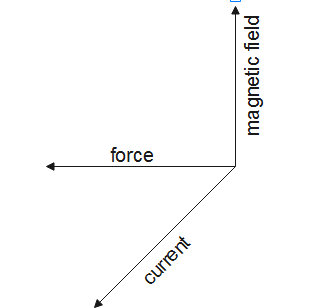
State the difference between Fleming's left-hand rule and Fleming’s right-hand rule. Name the electric devices where these two find their important application.
Answer
561.3k+ views
Hint: In this question, we will first find what are the basic concepts of the two rules i.e., Fleming's left-hand rule and Fleming’s right-hand rule. Since, both the field tells us about direction of field, force or current, their application will be based on their basic rule.
Complete step-by-step answer:
We know that Fleming's left-hand rule gives the direction of magnetic force acting on a conductor whereas; Fleming’s right-hand rule gives us the direction of induced current.
Fleming’s right-hand rule can be understood as: from this rule, if we stretch the thumb, forefinger and middle finger of our right hand such that they are mutually perpendicular to each other. Here, if the forefinger point indicates the direction of the magnetic field and the thumb indicates the direction of motion of the conductor, then the middle finger will indicate the direction of induced current in the conductor.

Fleming’s left-hand rule: from this rule if we stretch our thumb, forefinger and middle finger of the left hand such that all these fingers are mutually perpendicular to each other. So, if the forefinger points in the direction of the magnetic field and the middle finger indicates the direction of the current, then the thumb will indicate the direction of motion or the force on the conductor.

Their applications in the electric devices are:
Fleming's left-hand rule is used to find the direction of magnetic force acting in electric motors. We know that an electric current and magnetic field exist in an electric motor, and these lead to the force that creates the motion. So, the left hand rule is used here which gives the direction of magnetic force acting in the electric motor.
Fleming's right-hand rule is used to find the direction of induced current in an electric generator. As we know that in an electric generator, the motion and magnetic field exist and these lead to the production of an electric current in the generator. So, the right hand rule is used here to find the direction of induced current in an electric generator.
Additional Information: A magnetic field B can be defined as a vector field that tells the magnetic influence on moving electric charges, electric currents, and magnetized materials. Also, we should know that a charge that is moving in a magnetic field experiences a force that is perpendicular to its town velocity and to the magnetic field.
Note: Do remember the rules because both the rules tell the different fields. Further, we need to notice the direction of the magnetic field i.e., whether the field is inward or outward. All the three fingers should be placed perpendicular to each other.
Complete step-by-step answer:
We know that Fleming's left-hand rule gives the direction of magnetic force acting on a conductor whereas; Fleming’s right-hand rule gives us the direction of induced current.
Fleming’s right-hand rule can be understood as: from this rule, if we stretch the thumb, forefinger and middle finger of our right hand such that they are mutually perpendicular to each other. Here, if the forefinger point indicates the direction of the magnetic field and the thumb indicates the direction of motion of the conductor, then the middle finger will indicate the direction of induced current in the conductor.

Fleming’s left-hand rule: from this rule if we stretch our thumb, forefinger and middle finger of the left hand such that all these fingers are mutually perpendicular to each other. So, if the forefinger points in the direction of the magnetic field and the middle finger indicates the direction of the current, then the thumb will indicate the direction of motion or the force on the conductor.

Their applications in the electric devices are:
Fleming's left-hand rule is used to find the direction of magnetic force acting in electric motors. We know that an electric current and magnetic field exist in an electric motor, and these lead to the force that creates the motion. So, the left hand rule is used here which gives the direction of magnetic force acting in the electric motor.
Fleming's right-hand rule is used to find the direction of induced current in an electric generator. As we know that in an electric generator, the motion and magnetic field exist and these lead to the production of an electric current in the generator. So, the right hand rule is used here to find the direction of induced current in an electric generator.
Additional Information: A magnetic field B can be defined as a vector field that tells the magnetic influence on moving electric charges, electric currents, and magnetized materials. Also, we should know that a charge that is moving in a magnetic field experiences a force that is perpendicular to its town velocity and to the magnetic field.
Note: Do remember the rules because both the rules tell the different fields. Further, we need to notice the direction of the magnetic field i.e., whether the field is inward or outward. All the three fingers should be placed perpendicular to each other.
Recently Updated Pages
Master Class 12 English: Engaging Questions & Answers for Success

Master Class 12 Economics: Engaging Questions & Answers for Success

Master Class 12 Social Science: Engaging Questions & Answers for Success

Master Class 12 Maths: Engaging Questions & Answers for Success

Master Class 12 Chemistry: Engaging Questions & Answers for Success

Master Class 12 Business Studies: Engaging Questions & Answers for Success

Trending doubts
What are the major means of transport Explain each class 12 social science CBSE

Which are the Top 10 Largest Countries of the World?

Draw a labelled sketch of the human eye class 12 physics CBSE

Explain sex determination in humans with line diag class 12 biology CBSE

The pH of the pancreatic juice is A 64 B 86 C 120 D class 12 biology CBSE

Explain sex determination in humans with the help of class 12 biology CBSE




